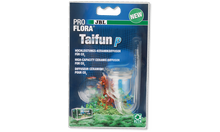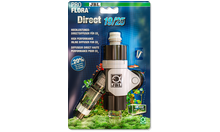Ideal nutrition for plants
The right CO2 concentration in the water is of great importance for the aquarium plants. Carbon dioxide is the main nutrient for plants and promotes their growth. Plants use the CO2 for the photosynthesis and thus supply the water with essential oxygen. They prevent algae growth, remove pollutants, provide hiding places and reduce pathogens.
Even enrichment
The JBL diffuser supplies the aquarium water with the main plant nutrient CO2 in even-sized bubbles. Easy to install The diffuser is suitable for all usual CO2 systems. Connect to CO2 hose with 4/6 mm. Attach diffuser with suction holder in the aquarium.
Effective
The built-in special ceramic ensures especially small and even-sized bubbles. Diffuser in high-quality glass design. The correct CO2 amount varies from aquarium to aquarium and depends on the volume, the water movement and the planting of the aquarium. You can check the CO2 content by means of a CO2 test.
JBL ProFlora Taifun P
Mini CO2 diffuser for nano freshwater aquariums
PROFLORA Taifun P
- Optimal enrichment with main plant nutrient carbon dioxide: CO2 diffuser for nano freshwater aquariums from 20 up to 400 l
- Even release and effective distribution: special ceramic for very small CO2 bubbles, built-in ceramic diaphragm
- Even release and effective distribution: special ceramic for very small CO2 bubbles, built-in ceramic diaphragm
- High-quality glass design
- Package contents: mini CO2 diffuser ProFlora Taifun P Nano, incl. 1 suction holder

